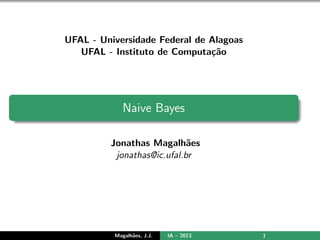
Naive Bayes
- 1. UFAL - Universidade Federal de Alagoas UFAL - Instituto de Computa¸˜o ca Naive Bayes Jonathas Magalh˜es a jonathas@ic.ufal.br Magalh˜es, J.J. a IA – 2013 1
- 2. Naive Bayes Baseado no Teorema de Bayes: P(B|A) ∗ P(A) P(A|B) = . (1) P(B) Seja X (A1 , A2 , ..., An , C ) um conjunto de dados de treinamento; Onde C1 , C 2, ..., Ck s˜o classes dos poss´ a ıveis valores de C ; R ´ um novo registro que deve ser classificado. e Os valores que R assume em X s˜o a1 , a2 , ..., an . a Magalh˜es, J.J. a IA – 2013 2
- 3. Naive Bayes Passos do algoritmo: 1 Calcular a probabilidade P(C = Ci |R), i = 1, 2, ..., k; 2 A sa´ ´ a classe Cj tal que P(C = Cj |R) seja m´xima. ıda e a A probabilidade de uma instˆncia pertencer a uma classe ´ dada por: a e P(C = Ci |A1 = a1 , A2 = a2 , ..., An = an ) = P(A1 = a1 |C = Ci ) ∗ P(A2 = a2 |C = Ci ) ∗ ... (2) ∗P(An = an |C = Ci ) ∗ P(C = Ci ). Magalh˜es, J.J. a IA – 2013 3
- 4. Naive Bayes – Exemplo Considere os seguintes dados: X 1 : Tempo de utiliza¸˜o ca X 2 : N´mero postagens u Y : Passou na disciplina 2 4 N˜o a 3 6 N˜o a 4 8 N˜o a 4 4 N˜o a 5 7 N˜o a 6 5 N˜o a 6 6 Sim 6 5 Sim 7 7 Sim 8 5 Sim 8 6 Sim 10 10 Sim Magalh˜es, J.J. a IA – 2013 4
- 5. Naive Bayes Discretizando os valores: Baixo: {0, 1, 2, 3} M´dio: {4, 5, 6, 7} e Alto: {8, 9, 10, 11} Magalh˜es, J.J. a IA – 2013 5
- 6. Naive Bayes Dados discretizados: Magalh˜es, J.J. a IA – 2013 6
- 7. Naive Bayes Deseja-se predizer se um aluno (instˆncia R) com... a Um n´mero m´dio de postagens (Postagens = m´dio), e; u e e Um n´mero m´dio de tempo de utiliza¸˜o (Tempo = m´dio). u e ca e ...Ir´ passar de ano ou n˜o (Passar = ?). a a Magalh˜es, J.J. a IA – 2013 7
- 8. Naive Bayes Calculando (Passar = sim | R): P(passou = sim | tempo = m´dio, postagens = m´dio) = e e P(postagens = m´dio | passou = sim) * P(tempo = m´dio | e e passou = sim) * P(passou=sim). P(postagens = m´dio | passou = sim) = ? e P(tempo = m´dio | passou = sim) = ? e P(passou=sim) = ? Magalh˜es, J.J. a IA – 2013 8
- 9. Naive Bayes 5 P(postagens = m´dio | passou = sim) = e 6 = 0.83 Magalh˜es, J.J. a IA – 2013 9
- 10. Naive Bayes Calculando (Passar = sim | R): P(passou = sim | tempo = m´dio, postagens = m´dio) = e e 0.83 * P(tempo = m´dio | passou = sim) * P(passou=sim). e P(postagens = m´dio | passou = sim) = 0.83 e P(tempo = m´dio | passou = sim) = ? e P(passou=sim) = ? Magalh˜es, J.J. a IA – 2013 10
- 11. Naive Bayes 3 P(tempo = m´dio | passou = sim) = e 6 = 0.5 Magalh˜es, J.J. a IA – 2013 11
- 12. Naive Bayes Calculando (Passar = sim | R): P(passou = sim | tempo = m´dio, postagens = m´dio) = e e 0.83 * 0.5 * P(passou=sim). P(postagens = m´dio | passou = sim) = 0.83 e P(tempo = m´dio | passou = sim) = 0.5 e P(passou=sim) = ? Magalh˜es, J.J. a IA – 2013 12
- 13. Naive Bayes 6 P(tempo = m´dio | passou = sim) = e 12 = 0.5 Magalh˜es, J.J. a IA – 2013 13
- 14. Naive Bayes Calculando (Passar = sim | R): P(passou = sim | tempo = m´dio, postagens = m´dio) = e e 0.83 * 0.5 * 0.5 = 0.21. P(postagens = m´dio | passou = sim) = 0.83; e P(tempo = m´dio | passou = sim) = 0.5; e P(passou=sim) = 0.5. Magalh˜es, J.J. a IA – 2013 14
- 15. Naive Bayes Calculando (Passar = n˜o | R): a P(passou = n˜o | tempo = m´dio, postagens = m´dio) = a e e 0.5 * 0.67 * 0.5 = 0.17. P(postagens = m´dio | passou = n˜o) = 0.5; e a P(tempo = m´dio | passou = n˜o) = 0.67; e a P(passou=sim) = 0.5. Magalh˜es, J.J. a IA – 2013 15
- 16. Naive Bayes Classificando a instˆncia: a (Passar = n˜o | R) = 0.17; a (Passar = sim | R) = 0.21; Como (Passar = sim | R) > (Passar = n˜o | R), logo a predi¸˜o a ca sobre o aluno ´ que ele passar´ na disciplina. e a Magalh˜es, J.J. a IA – 2013 16
- 17. Perguntas? Magalh˜es, J.J. a IA – 2013 17
